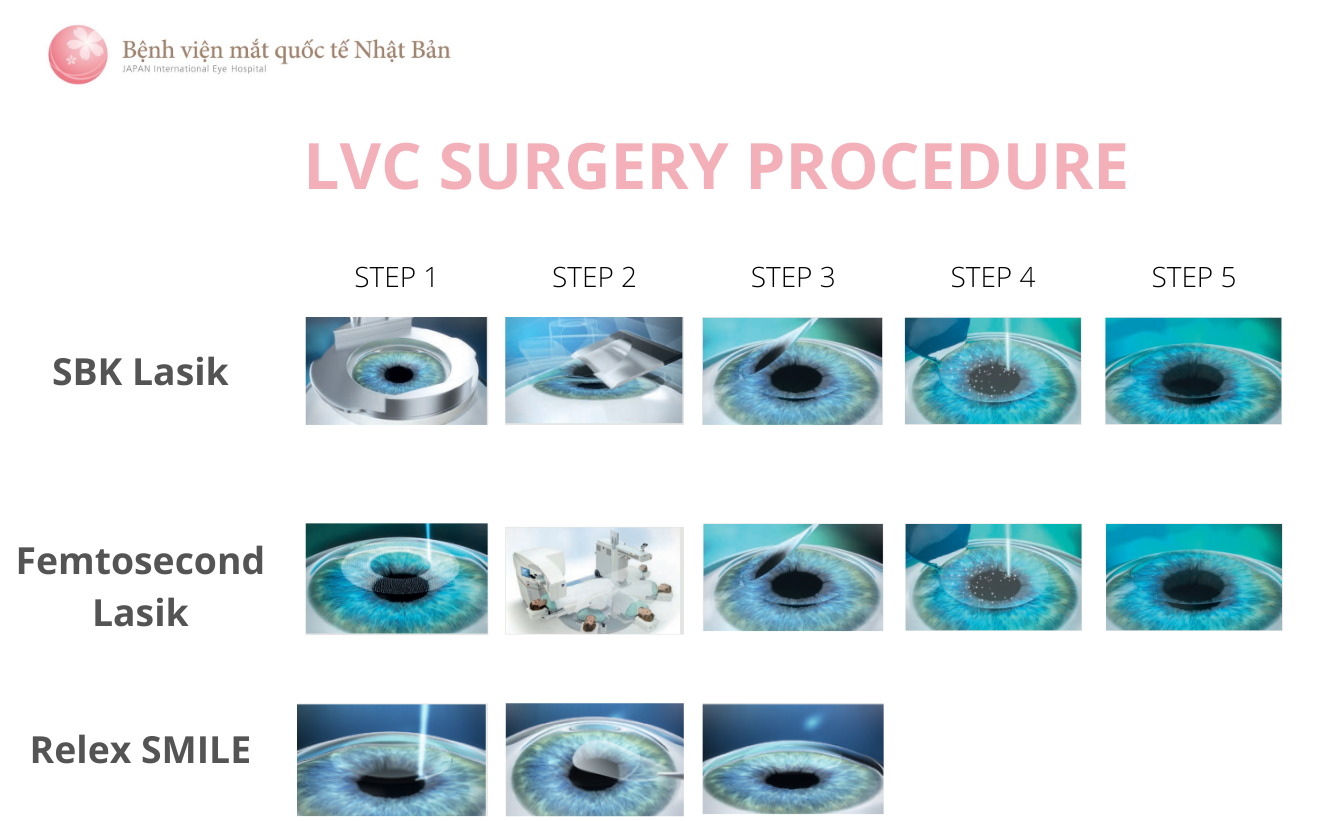LASER VISION CORRECTION (LVC) SURGERY: HOW TO TELL THE DIFFERENCE BETWEEN SBK LASIK, FEMTOSECOND LASIK OR RELEX SMILE?
Medical technology is progressing every day, so is Lasik surgery. The ultimate goal of LVC in specific, and refractive surgery in general is to free refractive patients from dependence on glasses or contact lenses, give them the ability to see with their naked eyes. Along with the scientific advance, medical advance now helps with better visual quality, healthier eye condition after LVC surgery. Depending on the technology applied and the surgical mechanism, there are three LVC methods: SBK Lasik, Femtosecond Lasik, and Relex SMILE. If you’re considering Lasik, you might have a hard time trying to differentiate those. So what makes them stand out, what are the advantages and disadvantages, in which case should which method be used? In this article, we will cover all of those information and partly help you get an overview of Laser vision correction surgery.
1. How it works?
With traditional LASIK – SBK Lasik, a controlled blade (microkeratome) is used to create the flap (a kind of hinged piece of corneal tissue). With advanced bladeless Femtosecond LASIK, a highly precise flap is quickly created with a femtosecond laser. With the development of SMILE, however, a minimally invasive procedure is now possible.
Prior to treatment, anesthetic eye drops are applied to the eye. An eyelid holder prevents the eye from blinking during the procedure.
Laser vision correction surgery steps:
LASIK SBK
- Step 1 - Preparing the treatment: A microkeratome is positioned in preparation of the flap cut
- Step 2 - Creating the flap: The microkeratome creates a flap, a hinged corneal piece of tissue.
- Step 3 - Folding back the flap: The flap is gently folded back, exposing the inner corneal tissue to be treated.
- Step 4 - Correcting the error: An excimer laser reshapes the corneal tissue, correcting the refractive error.
- Step 5 - Repositioning the flap: The flap is returned to its original position, protecting the eye like a natural bandage
Femtosecond Lasik
- Step 1 - Creating the flap: A flap is created with a highly precise femtosecond laser
- Step 2 - Relocating the patient: The patient is conveniently moved from the femtosecond laser (VISUMAX machine) to the excimer laser (Mel 90 machine).
- Step 3 - Folding back the flap: The flap is gently folded back, exposing the inner corneal tissue to be treated.
- Step 4 - Correcting the error: An excimer laser reshapes the corneal tissue, correcting the refractive error.
- Step 5 - Repositioning the flap: The flap is returned to its original position, protecting the eye like a natural bandage
ReLEx SMILE
- Step 1 - Creating the lenticule: A small piece of corneal tissue (lenticule) and a small incision are created inside the intact cornea
- Step 2 - Removing the lenticule: The lenticule is removed through the small incision with minimal disruption to the cornea
- Step 3 - Correcting the error: Removing the lenticule changes the shape of the cornea, correcting the refractive error

2. Benefits & Limitations:
LASIK - Flap surgery
Description
- Traditional LASIK (Lasik SBK): a flap, a hinged piece of corneal tissue, is created in the outer corneal layer with a controlled blade, folded back, and the underlying tissue is sculpted with a laser (tissue ablation).
- Advanced Femto-LASIK: a femtosecond laser is used to create a precise and predictable flap.
Benefits
- Normally quick visual recovery, typically, visual healing and recovery is faster than with PRK
- Extensive experience, has been the treatment standard for over 20 years
- Widely available, many clinics offer LASIK or Femto-LASIK
Limitations
- Potential flap complications like infection, flap dislocation or detachment
- Sounds and odors during surgery
- Potential side effects like dry eyes or foreign body sensation
RELEX SMILE - Minimally invasive surgery
Description
- A thin piece of tissue (lenticule) is created inside the cornea and removed through a small incision.
Benefits
- Minimally invasive due to only a small incision
- Gentle and convenient technique
- Requires no flap – no flap-related complications; low incidence of dry eyes, low risk of infection
- Generally greater suitability – possible option for patients with contact lens intoleranceand a dry eye tendency
Limitations
- Not yet available for hyperopic (farsighted) patients
- Availability, not yet as widely performed as LASIK
- Side effects are very rare, but cannot be completly ruled out
The above information is for reference only. Although base on your own budget and eye condition, you can have a general idea of which method to use but to precisely decide, you need to have an eye examination and consultation with an ophthalmic doctor. We hope this information provided you an overview of how LVC takes place, and tell the differences between 3 LVC methods, the advantages, and disadvantages of each method. Should you need more consultation about Lasik surgery, please contact us or your trusted ophthalmologist before jumping to the conclusion.
